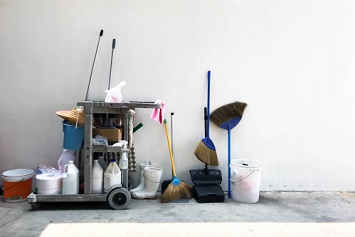Chemical exposure is a big safety and environmental hazard. But for a lot of facilities, the only chemicals they regularly use are cleaning supplies. However, only some employees (such as janitorial or facilities management staff) may be using stronger solvents, while other materials are being used by all employees throughout the entire workforce. So, who needs hazard communication (HazCom) training?
Consider this question in more detail: Let’s say the only chemicals you use regularly are basic cleaning solvents by your facilities team. But your entire workforce uses cleaning supplies from time to time in order to clean their workstations. When developing the training portion of the HazCom plan, would it need to be geared only towards your facilities team, who use a wide array of cleaning products, or the entire workforce, since they will use some of the supplies from time to team to clean their workstation?
The answer: If what you refer to as “cleaning supplies,” “cleaning solvents,” and “cleaning products” are not considered consumer products, then the HazCom plan and associated training needs to include all employees that may be exposed to the chemicals.
If the “cleaning supplies,” “cleaning solvents,” and “cleaning products” are considered consumer products, the consumer product exemption may potentially apply. The consumer product exemption, under 29 CFR 1910.1200(b)(6)(ix) states that if the consumer products are used in the workplace in the same manner that a consumer would use them, i.e.; where the duration and frequency of use (and therefore exposure) is not greater than what the typical consumer would experience, then those products are exempt from HazCom requirements. The California requirement under 8 CCR 5194(5)(G) mirrors the federal requirement by exempting from HazCom requirements “consumer products packaged for distribution to, and use by, the general public, provided that employee exposure to the product is not significantly greater than the consumer exposure occurring during the principal consumer use of the product.”
Therefore, if the products are used as part of an employee’s job, such as cleaning supplies by cleaning personnel, they do not qualify for the exemption and a safety data sheet (SDS), labeling, and HazCom training are required. Same applies if products are regularly used in a manner that results in a duration and frequency of exposure greater than what a normal consumer would experience. In these situations, workers have a right to know about the properties of those hazardous chemicals. It is your (i.e., the employer’s) responsibility to determine employee exposure and ascertain if the frequency of use/exposure is more than that which would be experienced by a normal consumer.
More information is available in this OSHA letter of interpretation.
Note: This question was answered by experts at Enviro.BLR.com.

